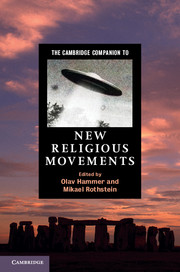Book contents
- Frontmatter
- Introduction to new religious movements
- Part I Social science perspectives
- Part II Themes
- Part III New religious movements
- 8 Scientology: up stat, down stat
- 9 Neopaganism
- 10 The International Raëlian Movement
- 11 The Sathya Sai Baba movement
- 12 Neo-Sufism
- 13 Satanism
- 14 Theosophy
- 15 The New Age
- 16 “Jihadism” as a new religious movement
- 17 New religious movements in changing Russia
- 18 New religious movements in sub-Saharan Africa
- Index
- Other titles in the series
11 - The Sathya Sai Baba movement
from Part III - New religious movements
Published online by Cambridge University Press: 28 September 2012
- Frontmatter
- Introduction to new religious movements
- Part I Social science perspectives
- Part II Themes
- Part III New religious movements
- 8 Scientology: up stat, down stat
- 9 Neopaganism
- 10 The International Raëlian Movement
- 11 The Sathya Sai Baba movement
- 12 Neo-Sufism
- 13 Satanism
- 14 Theosophy
- 15 The New Age
- 16 “Jihadism” as a new religious movement
- 17 New religious movements in changing Russia
- 18 New religious movements in sub-Saharan Africa
- Index
- Other titles in the series
Summary
The Sathya Sai Baba movement (SSB) is a transnational religio-cultural movement and social phenomenon. Approximately sixty-five years old, the movement had a single identifiable charismatic leader, Shri (honorific) Sathya Sai Baba, who was, until his death, the titular and acting head of a large global organization and a privately funded religious trust – the Sathya Sai Seva Organization and the Sai Charitable Trust. According to news reports, Sathya Sai Baba, god-man, guru, mystic, saint, “passed away” on April 24, 2011, Easter Sunday, at 7.40 a.m. Indian Standard Time, at the Sathya Sai Seva Institute for Higher Medical Sciences in his home town of Puttaparthi in rural Andhra Pradesh in south India after a month-long critical illness in which he was diagnosed with “multiple organ failure.”
On April 27, 2011, Sai Baba was given a state funeral, with a twenty-one-gun salute and a flag-draped coffin, attended by the President of India, Manmohan Singh, along with other prominent political figures, dignitaries, and celebrities. According to BBC reports, over half a million devotees are believed to have attended the public funeral ceremony, and a million-plus to have paid their last respects as his body lay in state in a crystal coffin for three days in the Sai Kulwant Darshan (sacred witnessing) Hall, where he would give his devotees darshan of himself (i.e., allowing his followers to behold him) twice daily. Sai Baba was buried, as is sometimes the custom for religious leaders, though most Hindus are cremated, and traditional Hindu rites were performed after the state funeral.
- Type
- Chapter
- Information
- The Cambridge Companion to New Religious Movements , pp. 184 - 197Publisher: Cambridge University PressPrint publication year: 2012

